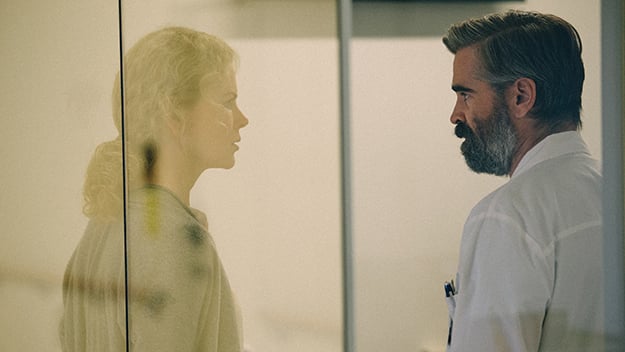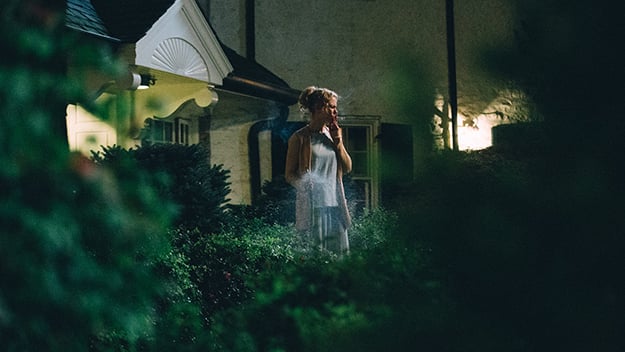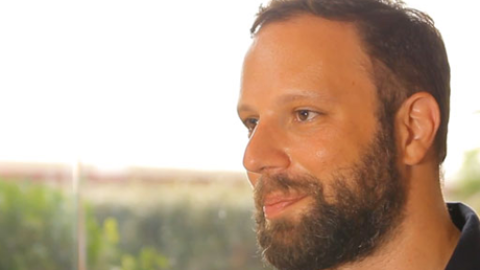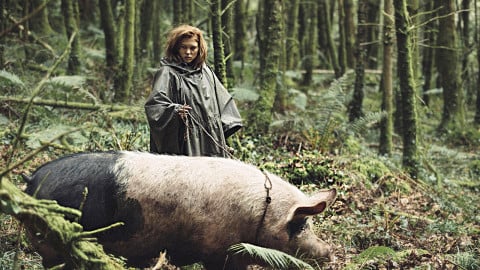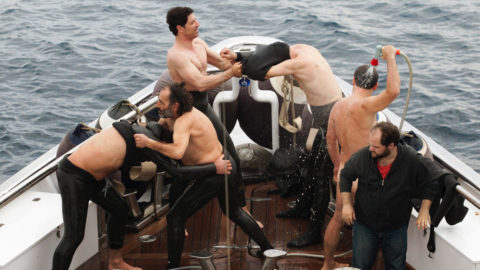Deep Focus: The Killing of a Sacred Deer
Yorgos Lanthimos, the director of the widely acclaimed movie The Killing of a Sacred Deer, which won a screenwriting prize at Cannes, practices fill-in-the-blank cinema. He offers outrageous premises, a self-conscious deadpan style, and actors skilled at straight-faced absurdity. Then he suckers us into providing meaning, feeling, context, and even the rules of his games. In the world of his commercial breakthrough film The Lobster (2016), single people get a month and a half to find and pair off with a suitable partner. They must share an emotional characteristic, like cruelty, or a physical one, like a propensity for nosebleeds. Otherwise, civil authorities transform them into an animal of their choice. (Our hero, played by Colin Farrell, selects the lobster as his fallback plan, both because he loves the sea and a lobster is long-lived.) Lanthimos never deigns to dramatize how society came to this sorry state, or why it hit on these particular practices. He leaves it to his fans to clarify his themes. One might hail The Lobster as a burlesque of governments legislating codes of intimacy; another might say it’s a satire of dating services that use algorithms to make the “perfect match.”
Lanthimos’s mode of riffing in a stiff, oracular manner can seem compelling and oddly funny, at least for a half-hour or so, even to skeptics like myself. Then we find ourselves following the four stages of aesthetic grief: denial (“No one, deep down, can take this seriously”); anger (“How dare he stoop to killing off the dog just to provoke us!”); bargaining (“If we regard this film as ‘pure cinema,’ it must get better”); and, finally, depression (“No, it doesn’t get any better”). Happily, for aesthetic grief, as opposed to grief, a fifth stage, “acceptance,” isn’t a necessity. We can always walk out of the theater.
With The Killing of a Sacred Deer, Lanthimos edges into Hitchcock-Polanski territory. It has the makings of a psychological thriller except, of course, for genuine psychology and thrills. Farrell once again proves himself a glutton for punishment as Stephen, a cardiothoracic surgeon at a cutting-edge hospital in the American Midwest. The movie begins with Farrell performing open-heart surgery as a blast of Schubert’s Stabat Mater fills the soundtrack. This one-two punch is supposed to set Stephen in our minds as a modern divinity, holding mortality in his hands. So when he and his anesthesiologist, Matthew (Bill Camp), stroll down a gleaming empty corridor and engage in stilted small talk about swank wristwatches, the deflating effect is thinly amusing, in the affected Lanthimos way. It turns out that Stephen eyes Matthew’s watch as a gift idea for a teenaged acquaintance, Martin (Barry Keoghan).
As usual for a Lanthimos film, any intrigue derives from the director’s tight fist with information. What is the connection between this distinguished man and this blank-faced boy? Why does Stephen welcome him into his immaculate suburban manse and introduce him to his beautiful and successful ophthalmologist wife Anna (Nicole Kidman), his 14-year-old daughter Kim (Raffey Cassidy), and his 12-year-old son Bob (Sunny Suljic)?
These questions would be more urgent if Lanthimos’s adults and children interacted more like people and less like programmed lab rats. (Dogtooth, Lanthimos’s first international critical hit, released in 2009 and nominated for an Academy Award, was like a sadistic behavioral experiment: bourgeois parents seal their children off from the world, in a home that functions as a closed state.) Even when he’s being “nice,” Martin oozes a bland sort of smarm. He knows that Kim is a choirgirl, so he presents her with a musical note attached to a keychain. Kim succumbs to him immediately instead of sensing that he’s an evil Eddie Haskell. At least Bob considers him some kind of threat and taunts him, saying his father has three times Martin’s underarm hair. Later, in a hospital examination room, Martin asks Stephen to lift his shirt so he can judge whether that’s a fair comparison. And Stephen actually does.
Whether in or out of the house, the “relationships” are as ingrown and absurd as the walled-in perversities of Dogtooth. Before Anna and Stephen make love, she lies straight and still across the bed in the “general anesthesia” position. Kim offers herself to Martin the same way, which suggests that she’s been spying around the master bedroom. These anti-erotic images typify how Lanthimos presents even primal action in a frigid and self-conscious style. It’s as if he directs actors and composes images while wearing surgical gloves and a breathing mask. Not even troupers like Farrell and Kidman stand a chance.
Lanthimos repeats and/or exaggerates flimsy, sometimes outré behavior in an attempt to fashion some intricate audiovisual architecture. But this movie is built on landfill and sand. When The Killing of a Sacred Deer descends to scenes of torture, the movie (and most audiences) can’t survive the shock.
The smug, stilted dialogue sounds as if it were written in Greek, run through Google Translate, then smoothed out with diction from Anglo-American plays of the 1950s.
Anna: “What a charming boy.”
Stephen: “Isn’t he?”
Anna: “Yes, very. How did his father die?”
Stephen says the man perished instantly in a car crash, but he expired on the operating table, when Stephen was operating and drinking. The surgeon thinks paternal friendship will serve as penance for his own misconduct and compensate Martin for his loss, but that’s not good enough for the boy. First Martin tries in vain to engineer an affair between the unsuspecting Stephen and his willing mother (Alicia Silverstone). Then he conjures a mystic-karmic curse involving paralysis, bleeding, and ultimately the death of Stephen’s family, unless he kills one of them first.
The title, and this curse, refers to a Greek myth that’s alluded to, but not explained, in the film itself. It’s as if Lanthimos and his cowriter, Efthymis Filippou, are engaging in a cultural form of name-dropping. As the story goes, when Agamemnon massed his troops to sail to Troy, he inadvertently killed a deer sacred to the goddess Artemis, and could appease her only by sacrificing his daughter, Iphigenia. We get that Stephen, as a surgeon, possesses godlike self-regard. But Alec Baldwin had more resonance and fun as another cardiothoracic surgeon in Malice 24 years ago, especially when he listed his Harvard degree and other prestige certifications and proclaimed, “I am God!” Besides, invoking the Agamemnon-Iphigenia myth cannot turn Martin, a total loser of a kid, into a figure comparable to Artemis, the goddess of the hunt.
By default, the movie’s subject becomes the bankruptcy of upper-middle-class mores. Stephen keeps his reputation intact because of the hospital’s status system. Even working friendships are transactional. When Anna asks Matthew to tell her the real story behind the death of Martin’s father, the anesthesiologist demands a hand job first. (Alas, it’s not terribly diverting that Stephen says, “An anesthesiologist can kill a patient, but a surgeon never can,” and Matthew says, “A surgeon can kill a patient, but an anesthesiologist never can.”) Home revolves around mealtime rituals and household tasks and extracurricular accomplishments, such as Kim’s singing. It’s meant to be poignant and sardonic when Kim begs for her life by vowing never to forget her assigned chores. But the scene is just brutal. As for school, Kim may be a gifted student of the humanities, but nothing she’s learned has helped prepare her for this particular life-or-death turn—not even writing an A+ paper about Iphigenia.
Lanthimos may attract international art-house audiences precisely because of his abstractions. Some viewers may read profundities about justice and fate into the big empty holes of his narratives. They can perceive the sterile, deracinated lifestyles of his characters as bourgeois nightmares that could spread from one Western country to the next. These movies, though, are the bourgeois nightmares.
In the press notes, Farrell says, “At the story’s core lies this very black and insidious sickness—a kind of carcinogen or poison that courses through the film. We don’t get an answer to what the poison is.” How true. Because Lanthimos blends pretensions and vagaries with existential whammies that give rise to conflicting interpretations, it’s tempting to call The Killing of a Sacred Deer “a Rorschach test.” But the inkblots of a Rorschach test trigger multiple associations and open up the human personality. This film devolves into single-minded scare tactics and reduces its actors to mannequins or torture toys. It drains all personality away.
Michael Sragow is a contributing editor to Film Comment and writes its Deep Focus column. He is a member of the National Society of Film Critics and the Los Angeles Film Critics Association. He also curates “The Moviegoer” at the Library of America website.



